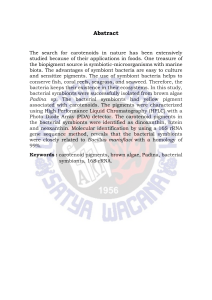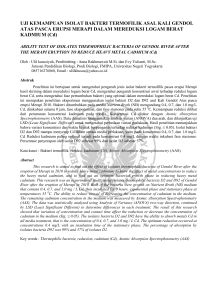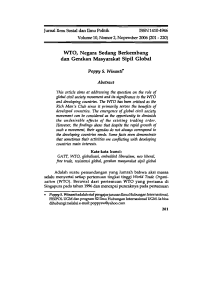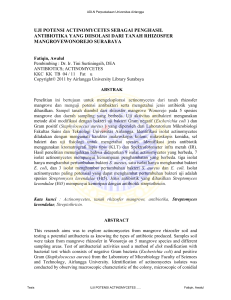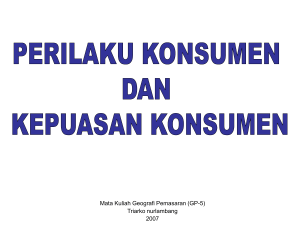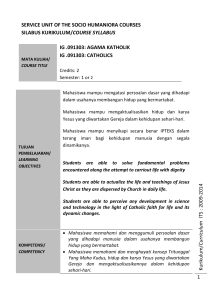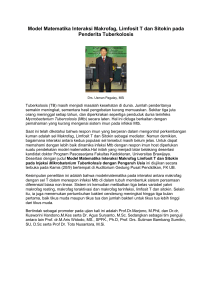GEN 16S rRNA BAKTERI Geobacillus
advertisement
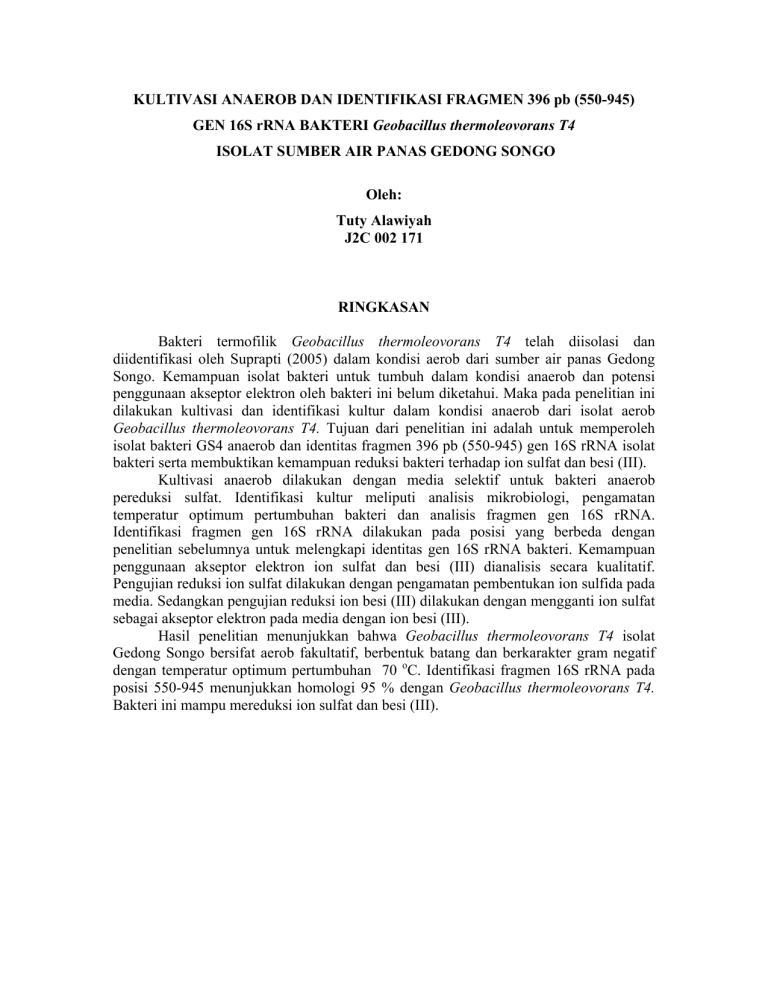
KULTIVASI ANAEROB DAN IDENTIFIKASI FRAGMEN 396 pb (550-945) GEN 16S rRNA BAKTERI Geobacillus thermoleovorans T4 ISOLAT SUMBER AIR PANAS GEDONG SONGO Oleh: Tuty Alawiyah J2C 002 171 RINGKASAN Bakteri termofilik Geobacillus thermoleovorans T4 telah diisolasi dan diidentifikasi oleh Suprapti (2005) dalam kondisi aerob dari sumber air panas Gedong Songo. Kemampuan isolat bakteri untuk tumbuh dalam kondisi anaerob dan potensi penggunaan akseptor elektron oleh bakteri ini belum diketahui. Maka pada penelitian ini dilakukan kultivasi dan identifikasi kultur dalam kondisi anaerob dari isolat aerob Geobacillus thermoleovorans T4. Tujuan dari penelitian ini adalah untuk memperoleh isolat bakteri GS4 anaerob dan identitas fragmen 396 pb (550-945) gen 16S rRNA isolat bakteri serta membuktikan kemampuan reduksi bakteri terhadap ion sulfat dan besi (III). Kultivasi anaerob dilakukan dengan media selektif untuk bakteri anaerob pereduksi sulfat. Identifikasi kultur meliputi analisis mikrobiologi, pengamatan temperatur optimum pertumbuhan bakteri dan analisis fragmen gen 16S rRNA. Identifikasi fragmen gen 16S rRNA dilakukan pada posisi yang berbeda dengan penelitian sebelumnya untuk melengkapi identitas gen 16S rRNA bakteri. Kemampuan penggunaan akseptor elektron ion sulfat dan besi (III) dianalisis secara kualitatif. Pengujian reduksi ion sulfat dilakukan dengan pengamatan pembentukan ion sulfida pada media. Sedangkan pengujian reduksi ion besi (III) dilakukan dengan mengganti ion sulfat sebagai akseptor elektron pada media dengan ion besi (III). Hasil penelitian menunjukkan bahwa Geobacillus thermoleovorans T4 isolat Gedong Songo bersifat aerob fakultatif, berbentuk batang dan berkarakter gram negatif dengan temperatur optimum pertumbuhan 70 oC. Identifikasi fragmen 16S rRNA pada posisi 550-945 menunjukkan homologi 95 % dengan Geobacillus thermoleovorans T4. Bakteri ini mampu mereduksi ion sulfat dan besi (III). SUMMARY A thermophilic bacteria isolate, Geobacillus thermoleovorans T4, was recovered and identified by Suprapti (2005) in aerobic condition from Gedong Songo hot spring. The ability of this isolate to grow in anaerob condition and the use of electron acceptors by this isolate has not been recovered. In order that, the study of cultivation and identification of the culture in anaerobic condition from aerobic isolate of Geobacillus thermoleovorans T4 should be done. The aim of this study was to obtain an anaerobic bacteria isolate of Geobacillus thermoleovorans T4 and to identify 396 bp (550-945) of 16S rRNA gene fragment as well as to prove the capability of the culture to reduce sulphate and ferric ions. Anaerobic cultivation was conducted using selective medium for sulphate reducing bacteria. Culture identification included microbiology analysis, optimum growth temperature determination and 16S rRNA gene fragment analysis. The analysis of 16S rRNA gene fragment included DNA extraction, electrophoresis of DNA extract, in vitro amplification of the fragment using PCR, electrophoresis of amplified fragment, sequencing, and analyzing the resulted sequence. The identification of 16S rRNA gene fragment was performed at different position from the recent study to complete the identity of 16S rRNA gene of the isolate. The ability of the culture to use sulphate and ferric ions as electron acceptors were analyzed qualitatively. Sulphate reduction was tested by monitoring the formation of sulphide in medium. Ferric reduction was tested by substitution of sulphate with ferric as an electron acceptor in medium. The study revealed that the isolate of Geobacillus thermoleovorans T4 from Gedong Songo was facultatively aerobic, rod shaped with gram negative characteristic and grew optimally at 70 oC. Identification of 16S rRNA gene fragment at 550-945 positions showed 95% homology with Geobacillus thermoleovorans T4. This anaerobic isolate reduced sulphate and ferric ions. DAFTAR PUSTAKA Altman, R., 2000, The Structure of 16S Ribosomal RNA, Pub Med Journal, Stanford Section of Medical and Informatics, Stanford. Anonim, 2000, Microbiology and Bacteriology: The World of Microbes, Department of Bacteriology, University of Wisconsin, Madison. Barry, T., Powell, R., dan Gannon, F., 1990, “A General Method to Generate DNA Probes for Microorganisms”, Bio/Technology, 8, p. 233-236. Brock, Thomas D., 1979, Biology of Microorganisms, 3rd ed., Prenctice-Hall Inc., New jersey. Brow, M.A.D., 1990, Sequencing with Taq DNA Polymerase, Academic Press Inc., p. 189-205. Caccavo, F., Lonergan, D.J., Lovley, D.R., Davis, M., Stolz, J.F. and McInerney, M.J., 1994, Geobacter Sulfurreducens sp.nov., a Hydrogen and Acetat-Oxidizing Metal Reducing Microorganism, Applied and Environmental Microbiology, American Society of Microbiology, vol. 60, no. 10, p. 3752-3759. Carman, D.R., 2001, Bacterial Characteristics: Introduction to Bacteriology, Micro., 6, 11-23. Chapelle, F.H., 2001, Ground-Water Microbiology and Geochemistry, Second edition, John-Wiley and Son Inc., New York, p. 22, 73-74, 99. DeFlaun, M.F., Fredrickson, J.K, Dong, H., Pfiffner, S.M., Onstott, T.C., Balkwill, D.L., Streger, S. H., Stackebrandt, E., Knoessen, S dan van Heerden, E., 2004, Isolation and Characterization of a Geobacillus Thermoleovorans Species From an UltraDeep South African Gold Mine, Systematic and Applied Microbiology, Miami. Festl, H., Ludwig, W., dan Schleifer, K. H., 1986, “DNA Hybridization Probe for Pseudomonas fluorescnce Group”, Appl. Environ. Microbiol., 56, 1190-1194. Hartiko, H., 1999, Biologi Mikroorganisme Termofilik, UGM Press, Yogyakarta. Hayat, K., Nawaz, H., Latif, F. and Asghar, M., 2001, Kinetics of Cellulase and Xylanase of Chaetomium thermophile with Respect to Aeration, Pakistan Journal of Biological Sciences, Vol. 4 (7), p. 875-876. Higgins, J.P., dan Hard, B.C., 2003, Bioremediation of Rock Drainage SulphateReducing Bacteria, Nature Work Remediation Corporation, Ontario. Innis, M.A., Gelfand, D.H., Sninsky, J.J. and White, T.J., 1990, PCR Protocol: A Guide to Methods and Applications, Academic Press Inc., California, p. 3. Kiran, Ö., Çömlekçîoğlu, U., dan Arikan, B., 2004, Effects of Carbon Sources and Various Chemicals on the Production of a Novel Amylase from a Thermophilic Bacillus sp. K-12, Turkish Journal of Biology, Kahramanmaraf Sütçü ‹mam University, Faculty of Arts and Sciences, Department of Biology, Kahramanmaraf, p. 99-103. Kirk, M.F., Holm, T.R., Park, J., Jin, Q., Sanford, R.A., Fouke, B.W., dan Bethke, C.M., 2004, Bacterial Sulfate Reduction Limits Natural Arsenic Contamination in Groundwater, Geology, v. 32, no. 11, p. 953–956. Lay, B.W., 1994, Analisis Mikroba di Laboratorium, Raja Grafindo Persada, Jakarta, p. 18, 40-41, 59-61. Lewin, B., 1998, Genes VI, Oxford University Press, New York, p. 178-187. Methe´, B. A., Nelson, K. E., Eisen, J. A. and Paulsen, I. T., 2003,Genome of Geobacter sulfurreducens: Metal Reduction in Subsurface Environments, Science Reports, Vol. 37, p. 1967-1969. Mifflin, H., 2004, Dictionary Definition of Gram’s Method, The American Heritage: Â Dictionary of the English Language, Fourth Edition, Houghton Mufflin Company. Mudryk, A.J., Podgórska, B., Ameryk, A., dan Bolałek, J., 2000,The Occurrence and Activity of Sulphate-Reducing Bacteria in The Bottom Sediments of The Gulf of Gdańsk, Oceanologia, 42 (1), pp. 105-117. Rampersad, K., Goldstone, L.A. and Tivchev, G.N., 1998, Study of Methods for the Cultivation of Anaerobic Cellulose-degrading Bacteria, Water S.A., Vol. 24, Centre for Water and Wastewater Research, Department of Biotechnology, Durban, p. 343-346. Russell, P., 2002, i Genetics, Pearson Education, Inc., San Francisco, p. 187-189. Ruwisch, R.C., Lovley, D.R. and Schink, B., 1998, Growth of Geobacter sulfurreducens with Acetate in Syntrophic Cooperation with Hydrogen-Oxidizing Anaerobic Partners, Applied and Environmental Microbiology, Vol. 64, No. 6, Murdoch University, Perth, p. 2232–2236. Sacchi, C.T., Whitney, A.M., Mayer, L.W., Morey, R., Steigerwalt, A., Boras, A., Meyant, R.S. and Popovic, T., 2002, Sequencing of 16S rRNA gene: A rapid Tool for Identification of Bacillus Anthracis, Emerging Infectious Diseases Journal, Vol. 8, No.1. Sambrook, J. and Russell, D.W., 2001, Molecular Cloning: A Laboratory Manual, Third Edition, Cold Spring Harbor Laboratory Press, New York. Slobodkin, A., Reysenbach, A.L., Strutz, N., Dreier, M. and Wiegel1, J., 1997, Thermoterrabacterium ferrireducens gen. nov., sp. nov., a Thermophilic Anaerobic Dissimilatory Fe(III)-Reducing Bacterium from a Continental Hot Spring, 1997, International Journal of Systematic Bacteriology, Vol. 47, No. 2, Department of Microbiology and Center for Biological Resource Recovery, University of Georgia, Athens, Georgia, p. 541–547. Sommer, P., Georgieva, T. and Ahring, B.K., 2003, Potential for Using Thermophilic Anaerobic Bacteria for Bioethanol Production from Hemicellulose, Thermophiles, Technical University of Denmark, Denmark, p. 283-289. Suprapti, H.Y., 2005, Isolasi dan Identifikasi Fragmen 16S rRNA Bakteri Termofilik Aerob Isolat Gedong Songo, Jawa Tengah, Skripsi, Universitas Diponegoro, Semarang. van den Burg, B., 2003, Current Opinion in Microbiology, Elsevier Science Ltd., p. 216218. van Lieshout, J., Faijes, M., Nieto, J., van der Oost, J. and Planas, A., 2004, Hydrolase and Glycosynthase activity of Endo-1,3- -Glucanase from the Thermophile Pyrococcus furiosus, Heron Publishing, Canada, p. 285-282. van Holde, K.E., Johnson, W.C. and Shing Ho, P., 1998, Principles of Physical Biochemistry, Prentice Hall, New Jersey, p. 213-221. Vogel, 1990, Analisis Anorganik Kualitatif Makro dan Semimikro, Edisi V, P.T. Kalman Media Pusaka, Jakarta. Ward, D.M., 2003, Diversity, Ecology and Evolution of Microorganisms Inhabiting Hot Spring Microbial Mats, Journal of NSF Frontiers of Integrative Biologycal Research. Zhou, J., Bruns, M.A., dan Tiedje, J.M., 1995, DNA Recovery from Soils of Diverse Composition, Applied and Environmental Microbiology, vol.62, no.2, p. 316-322.
